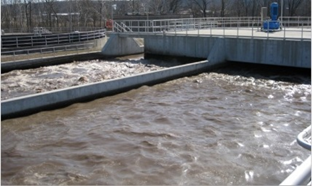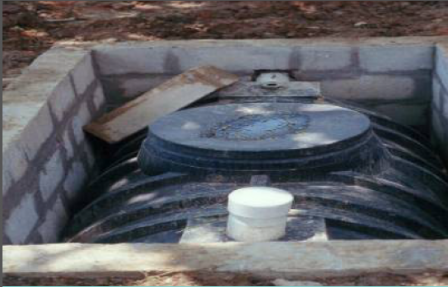Small Wastewater Systems Research
 In the U.S., there are approximately 15,617 operational public wastewater treatment facilities. Of these, approximately 72% (11,257) are considered ‘small systems’. EPA considers a wastewater system small if it serves a community with a population of 10,000 or fewer people and an average daily wastewater flow of less than one million gallons per day. Because small communities tend to be economically disadvantaged, under-served, and resource-poor, they face significant barriers to building and maintaining effective wastewater treatment services. Common challenges to achieving and maintaining sustainable wastewater treatment systems faced by small communities include economic/financial limitations, inability to sustain community-wide systems, inability to attract and maintain system operators, lack of managerial training and consistency, extreme topography and weather conditions, and geographic isolation/remoteness.
In the U.S., there are approximately 15,617 operational public wastewater treatment facilities. Of these, approximately 72% (11,257) are considered ‘small systems’. EPA considers a wastewater system small if it serves a community with a population of 10,000 or fewer people and an average daily wastewater flow of less than one million gallons per day. Because small communities tend to be economically disadvantaged, under-served, and resource-poor, they face significant barriers to building and maintaining effective wastewater treatment services. Common challenges to achieving and maintaining sustainable wastewater treatment systems faced by small communities include economic/financial limitations, inability to sustain community-wide systems, inability to attract and maintain system operators, lack of managerial training and consistency, extreme topography and weather conditions, and geographic isolation/remoteness.
- Fecal Pollution Source Tracking
Fecal source identification of septic system pollution in receiving waters
 In the United States, approximately 20% of all households are served by septic wastewater treatment systems. It is common for septic systems to fail due to age, design, poor operation and maintenance, and/or physical damage due to plant root infiltration. Direct discharge of waste into receiving waters with minimal or no treatment can pose a serious health risk when an impacted water source is used for recreation, a drinking water reservoir, irrigation, or aquaculture applications. To address these issues, EPA’s researchers are reviewing the microbial composition of septic waste, demonstrating the use of molecular technologies combined with geographic information system land use data to identify fecal pollution from failing septic systems in receiving waters, and evaluating fecal source identification aspects of septic system pollution.
In the United States, approximately 20% of all households are served by septic wastewater treatment systems. It is common for septic systems to fail due to age, design, poor operation and maintenance, and/or physical damage due to plant root infiltration. Direct discharge of waste into receiving waters with minimal or no treatment can pose a serious health risk when an impacted water source is used for recreation, a drinking water reservoir, irrigation, or aquaculture applications. To address these issues, EPA’s researchers are reviewing the microbial composition of septic waste, demonstrating the use of molecular technologies combined with geographic information system land use data to identify fecal pollution from failing septic systems in receiving waters, and evaluating fecal source identification aspects of septic system pollution.Tracking fecal pollution sources in Puerto Rico
In collaboration with the University of Puerto Rico and EPA Region 2 personnel, researchers evaluated microbial source tracking (MST) markers - a technique used to identify the sources of fecal bacteria in the environment - for watershed samples collected from the Río Grande de Arecibo (RGA) watershed, the Island’s third largest source of drinking water. This represents the largest study of its kind conducted in a tropical setting. EPA also used MST data to map fecal source hotspots in the RGA watershed.
- Decentralized Wastewater Treatment
Innovative Technologies for High Rate Treatment
Wet weather runoff that flows from urban communities into municipal wastewater collection systems, are significant challenges to wastewater utilities. Runoff from unpredictable strong storms or continuous heavy rain events can result in rapid changes in flow rates and volumes of wastewater that must be collected and treated, and can exceed design flows for treatment processes at the utility. In many cases, the pipe system carrying the water to the facility exceeds its holding capacity, resulting in sanitary or combined sewer overflows. In addition, there is a need for reliable data on emerging and priority contaminants released to receiving waters affected by centralized and decentralized wastewater treatment systems.
To eliminate sewer overflows and the related wash out of biological treatment processes during wet-weather events, municipalities are increasingly employing high rate treatment (HRT) systems. HRT evaluation studies are currently ongoing wastewater treatment plants. EPA studies are looking at the effectiveness of HRT’s and its comparison to secondary treatment.
Development of wastewater treatment for rural communities in Puerto Rico to protect reservoirs
Through the Watersheds Stewardship Program, EPA and Puerto Rico’s Department of Health, the Environmental Quality Board, the Department of Natural and Environmental Resources, and the Aqueducts and Sewers Authority are attempting to develop and implement replicable and affordable pollution control strategies to protect the Río Grande de Loíza and Río La Plata Watersheds which drain to reservoirs. The pilot projects will evaluate whether using community “gray water gardens” is a potential means of treatment of domestic wastewater in rural, poorly serviced areas, rather than the current practice of discharging it to the nearest water body or drainage system where is eventually ends up in drinking water reservoirs. Gray water is the wastewater from bathroom sinks, shower drains, and clothes washing machines. If this practice is successful it could be adopted by communities throughout Puerto Rico.
- Databases
Water Infrastructure Database (WATERiD) Exit
This database helps utilities choose the best pipe rehabilitation, condition assessment, and pipe-location determining technologies for both wastewater conveyance systems and drinking water distribution systems. It includes primary information about individual renewal technologies' cost and performance, case studies for their real world applications, and the list of vendors, consultants, and contractors available for a particular technology on a regional basis. The database allows utilities to input their experiences in these areas for the benefit of other utilities. This is a collaboration with Virginia Tech and EPA.
National Database Structure for Life Cycle Performance Assessment of Water and Wastewater Rehabilitation Technologies
This database houses performance evaluation data for rehabilitation technologies used in the water and wastewater sectors on a national basis, including additional cured-in-place pipe (CIPP) liner testing. The database will improve the utilities capability to sustainably manage their aging and deteriorating water distribution, stormwater and wastewater collection systems, and will help increase acceptance of new and innovative technologies by decision makers who adopt, regulate, and design infrastructure technologies. The databases can also assist utilities to more effectively implement comprehensive asset management, provide reliable service to their customers, and meet their Clean Water Act and Safe Drinking Water Act requirements. This will accelerate the development, evaluation, and market acceptance of the rehabilitation technologies.
- Webinars
State and local officials across the Nation are faced with challenges of effectively communicating information and overseeing training for small wastewater system owners and operators with a wide range of expertise, skills, and preferences for modes of communication. These officials need to stay up-to-date on treatment alternatives, regulations, health implications, and emerging contaminants. EPA is committed to helping state and local personnel, as well as small system personnel, to deliver high quality drinking water to their customers by providing information, training, and technical assistance. EPA’s small systems outreach efforts foster collaboration and dissemination of information, which, in turn, will help state agencies communicate the latest scientific advancements and current guidance to their small systems. In addition, EPA’s outreach efforts provide invaluable information from the states to EPA researchers on the problems that they are currently encountering in their day-to-day interactions with small systems. EPA scientists can then modify their research to solve real-world problems that small systems are experiencing.
Small drinking water and wastewater systems monthly webinars
EPA hosts a monthly webinar series, Challenges and Treatment Solutions for Small Drinking Water and Wastewater Systems, which provides information and training to hundreds of state and local agency personnel across the Nation. This webinar series provides a forum for EPA to communicate current small systems research in concert with Agency priorities directly to state personnel, EPA Regions, and other drinking water and wastewater small systems professionals, which allows EPA to provide training and foster collaboration and dissemination of information, to help state and local agencies communicate current information to their small systems.
